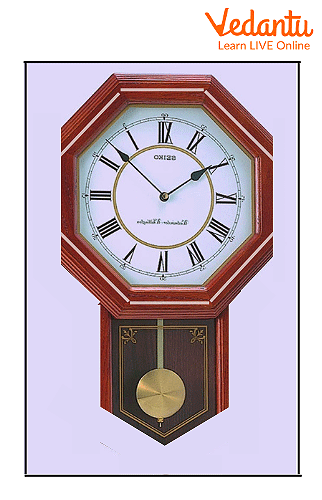




What is Pendulum?
A pendulum is defined as a free-swinging mass anchored at a fixed point. In physics, when studying pendulums, it is customary to model motion using a simple pendulum (A pendulum that swings back and forth). A simple pendulum is a simplified model that assumes that the tether is massless and that the mass is a spherical and uniform point of mass. Besides the physical structure of the pendulum, there are two defining characteristics: simple harmonic motion and its dependence on gravity.
Simple Harmonic Motion is an oscillatory motion created by a restoring force around an equilibrium point, and the motion of a pendulum is only one form of Simple Harmonic Motion. Gravity (The force of the earth that pulls everything down) is also a defining characteristic of a pendulum because even though some pendulums have an external driving force, it is gravity trying to pull the mass back into an equilibrium that creates the characteristic oscillating motion of a pendulum.
How Do Pendulums Works?
A simple pendulum consists of a mass or weight, known as a bob, which is hung from a wire, or cable, of a fixed length and fixed at a pivot point. When the pendulum is shifted from its initial position to an initial angle and released, it rotates freely back and forth with the periodic motion. All simple pendulums must have the same period, which is the time of one complete cycle of a left swing and a right swing, regardless of their initial angle.

Simple Pendulum Works
How are Pendulums Used Today?
5 applications of simple pendulum in today's time:
There are various uses for pendulums in real life. Out of which few are listed below:
Clock: Depending on the age and style of the clock, a giant pendulum or quartz crystal vibrates to keep time. A pendulum is used to maintain the accuracy of a mechanical clock. The length of the pendulum and the force of gravity both affect the time it takes for the pendulum to swing, which is called the period.

A Pendulum Clock
Playground Swing: Most kids have been on swings since being able to walk, whether in an infant swing at home, a baby swing at the playground, or a swing in your garden. Here, as in this case, the child acts as a mass suspended by ropes on both sides of the attached seat of the swing, which can move freely once the speed is set. This motion can be started by taking the swing slightly backwards with the help of the foot and then releasing it.
Bungee Jumping: In this technique, a long, elastic rope is attached to a person's ankles, which is then jumped off a bridge or platform, producing multiple vertical oscillations. A precise calculation is made to determine the amplitude of the oscillations, as a calculation error can result in loss of life. To avoid harm, this sport should only be practised with as many safety measures in place as possible.
Amusement Park Rides: Now, the use of pendulums can be seen in sea dragons or giant boat swings in amusement parks. Note that a pendulum is made of an object with a pendulum hanging from the end of a rod or string, allowing the object to swing freely in the opposite direction. Newton's first law states that the resting element will remain at rest (if there is no outside interference), meaning that a motor must be used to lift the amusement park ride into the air.

Amusement Park Ride
Metronome: A metronome is an instrument that creates rhythmic ticks to help musicians maintain a consistent tempo while playing a composition. In this case, the structure is a kind of pendulum. In this example, the oscillating arm is fastened to the bottom of the frame. Within the metronome, a fixed counterweight is used to balance another weight attached to the oscillating arm.
Solved Questions
Write True or False.
Pendulums can not be used to measure time. - False
The use of pendulums can be seen in sea dragons or giant boat swings in amusement parks. - True.
The time of a given pendulum is constant. - True.
The motion of a simple pendulum is linear. - False.
Learning by Doing
Kids Activity: Pendulum of sand
Make a cone-shaped cup and fill it with sand or salt. Rotate the cone like a pendulum, letting the sand out through a hole in the bottom. Look at the pattern it made.
Summary
We have learned all about the pendulum; now, you can easily explain to anyone what a pendulum is and its applications. Remember, a pendulum is made up of an object that hangs from the end of a rod or wire and swings freely. Many examples of pendulums are included in our daily activities, such as clocks and playground swings.
FAQs on Pendulum Uses
1. Where did the word "Pendulum" come from?
The word "pendulum" is derived from the Latin "pendulus", meaning "hanging".
2. Who made the first pendulum clock, and in which year?
Dutch scientist Christiaan Huygens built the first pendulum clock in 1656, increasing the accuracy of time from 15 minutes to 15 seconds per day.
3. Who discovered the principle of pendulum?
Italian Physicist and Astronomer Galileo Galilei discovered the principle of the oscillating motion of the pendulum. He discovered the pendulum in 1581.









